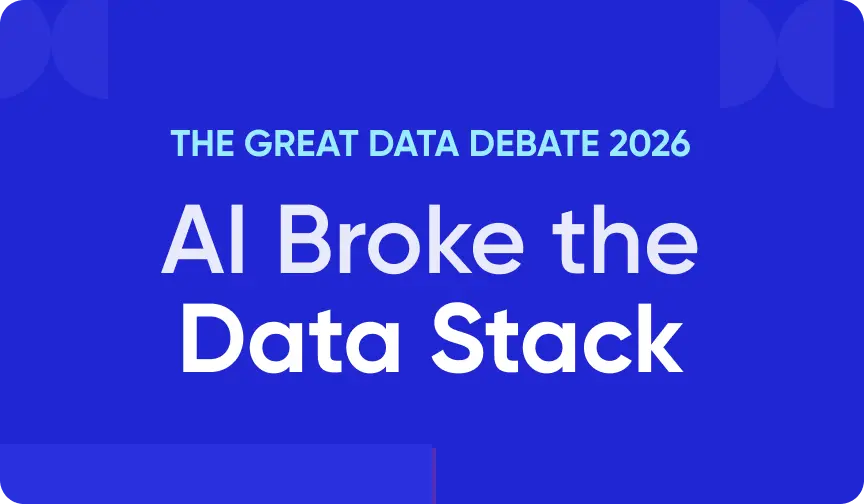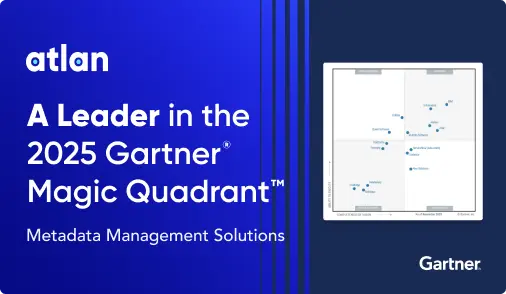What If Metadata (Not Models) Is the Real AI Infrastructure?

Last Updated on: May 19th, 2025 | 6 min read
Unlock Your Data's Potential With Atlan

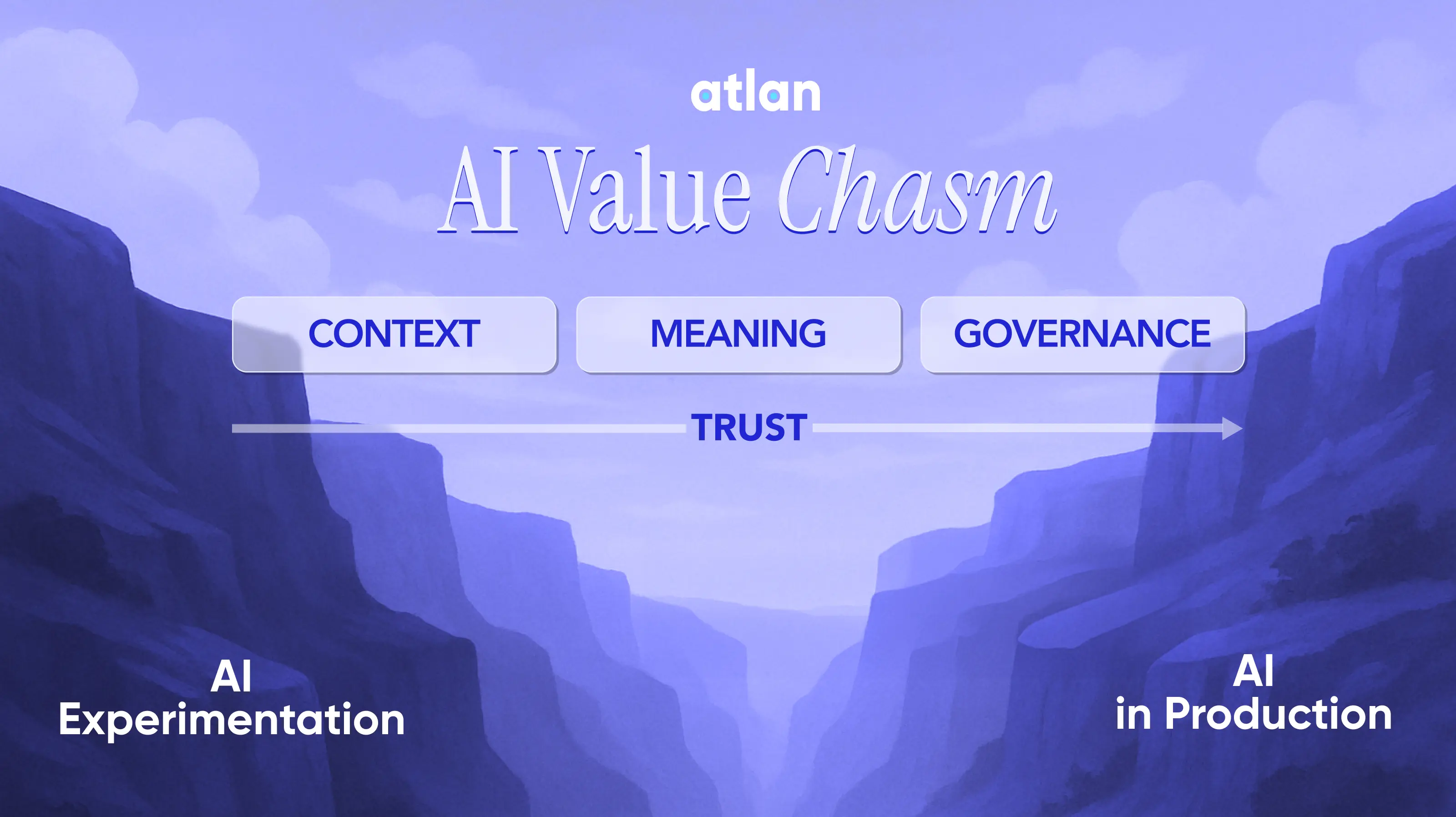
Most enterprise AI projects fail.
Permalink to “Most enterprise AI projects fail.”85% percent don’t scale. 42% percent are abandoned. Not because the models didn’t work, but because the inputs couldn’t be trusted and the outcomes couldn’t be explained.
This is the AI Value Chasm — the gap between pilots and production, between sandboxes and systems that scale.
That’s exactly what we unpacked in a recent Atlan + Snowflake webinar. The session brought together data and AI product leaders from Atlan and Snowflake, grounded in real-world examples of how leading enterprises are scaling AI in practice.
What emerged was a clear architectural insight: metadata, not models, is what carries trust across the chasm.
“Your data is consistent in your metadata layer, as well as your data storage layer.” —Mayur Mahadeshwar, Partner Sales Engineer, Snowflake
This kind of end-to-end consistency allows teams to apply policies at the point of use, not just at the point of storage. It’s what makes trust enforceable.
“We’re moving from a world where humans ask AI for help, to one where AI decides when to involve humans. And you can’t make that leap without trust.” —Sharif Karmally, VP of Product & Corporate Marketing, Atlan
That leap demands infrastructure that can explain, govern, and adapt in real time. Atlan and Snowflake argue that when unified across systems, metadata is that infrastructure.
Missed the session? Watch the full webinar here.
Three Hurdles Between Pilots and Production
Permalink to “Three Hurdles Between Pilots and Production”Hurdle 1: Metadata Lives Everywhere (Except Where AI Can See It)
Permalink to “Hurdle 1: Metadata Lives Everywhere (Except Where AI Can See It)”In a pilot, context is curated. Engineers work off a handful of clean tables, notes from the account team, and tribal knowledge. But in production, the data estate sprawls. Context fragments.
Documentation lives in Confluence. Lineage lives in dbt. Definitions live in Slack. Some of it lives only in people’s heads.
“I have a thousand AI use cases in my roadmap. But I don’t even know where to start, because I don’t even know what data we have for those use cases.” —CDO, Fortune 500 Technology Company
What Atlan + Snowflake enable:
- Metadata crawlers extract column-level context from Snowflake
- SQL parsing and dbt integrations trace lineage automatically
- Usage metadata and popularity scores come from Snowflake query logs
- Bi-directional tag sync ensures metadata consistency across systems
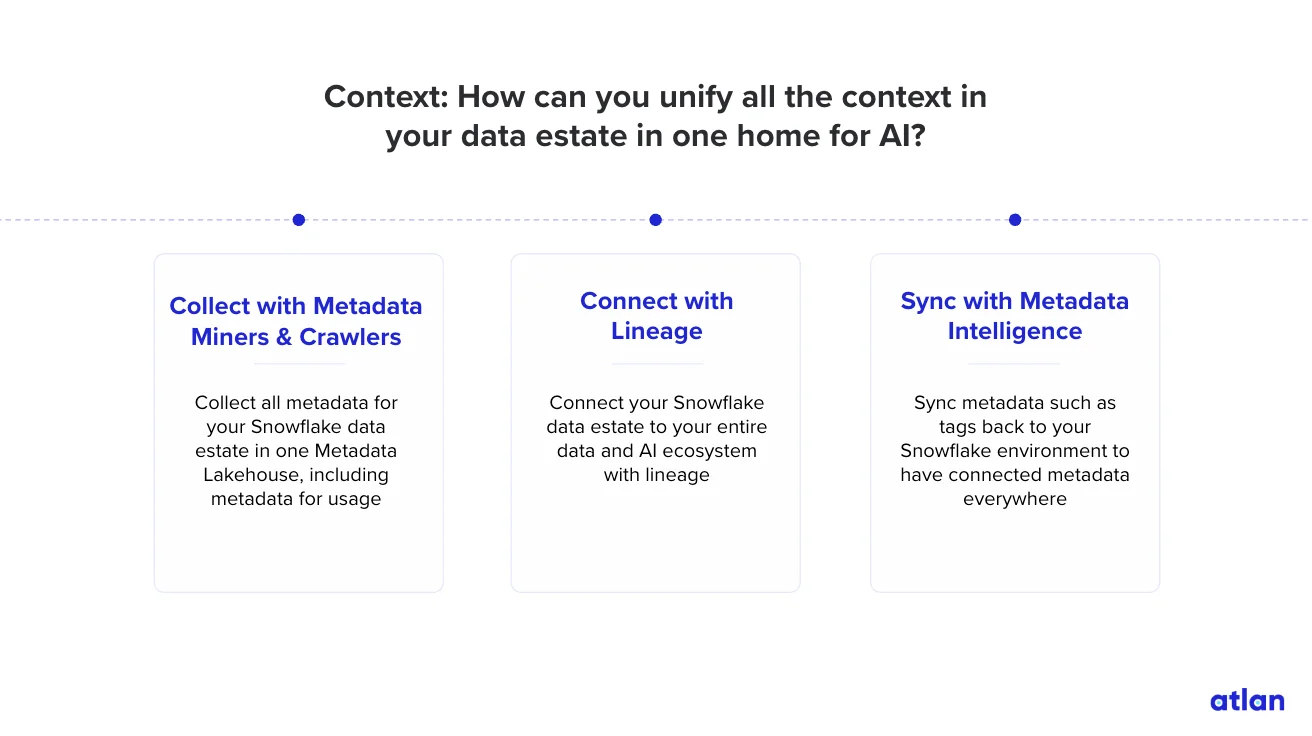
How can you unify all the context in your data estate in one home for AI? - Source: Atlan
“If a column is tagged as PII in Atlan, we can enforce masking policies directly in Snowflake, ensuring consistency across both storage and metadata layers.” —Mayur Mahadeshwar, Partner Sales Engineer, Snowflake
Result: context shifts from tribal to programmable.
Hurdle 2: AI Speaks English. It Doesn’t Speak Your Business.
Permalink to “Hurdle 2: AI Speaks English. It Doesn’t Speak Your Business.”LLMs can parse prompts. But they can’t distinguish whether “retention” means customer revenue, product usage, or talent churn.
“While I think dirty/missing data is a problem initially, I don’t think it is the route of the issue. I think the missing/dirty data exists because AI can’t clean it because it doesn’t have the business knowledge needed to clean the data.” — Seasoned Governance Professional with Fin. Serv. Org (Webinar Participant)
“TAM might mean a hundred things on the open internet, but at an investment firm, we have a very particular definition… How do I get AI to understand all of that business context?” —CIO, Investment Management Firm
What Atlan + Snowflake enable:
- Centralized glossaries and contracts linked to metadata and dbt YAMLs
- Atlan AI generates natural-language previews and definitions
- Right-to-left workflows flag undefined terms for human review
- Slack, Jira, and email flows operationalize governance
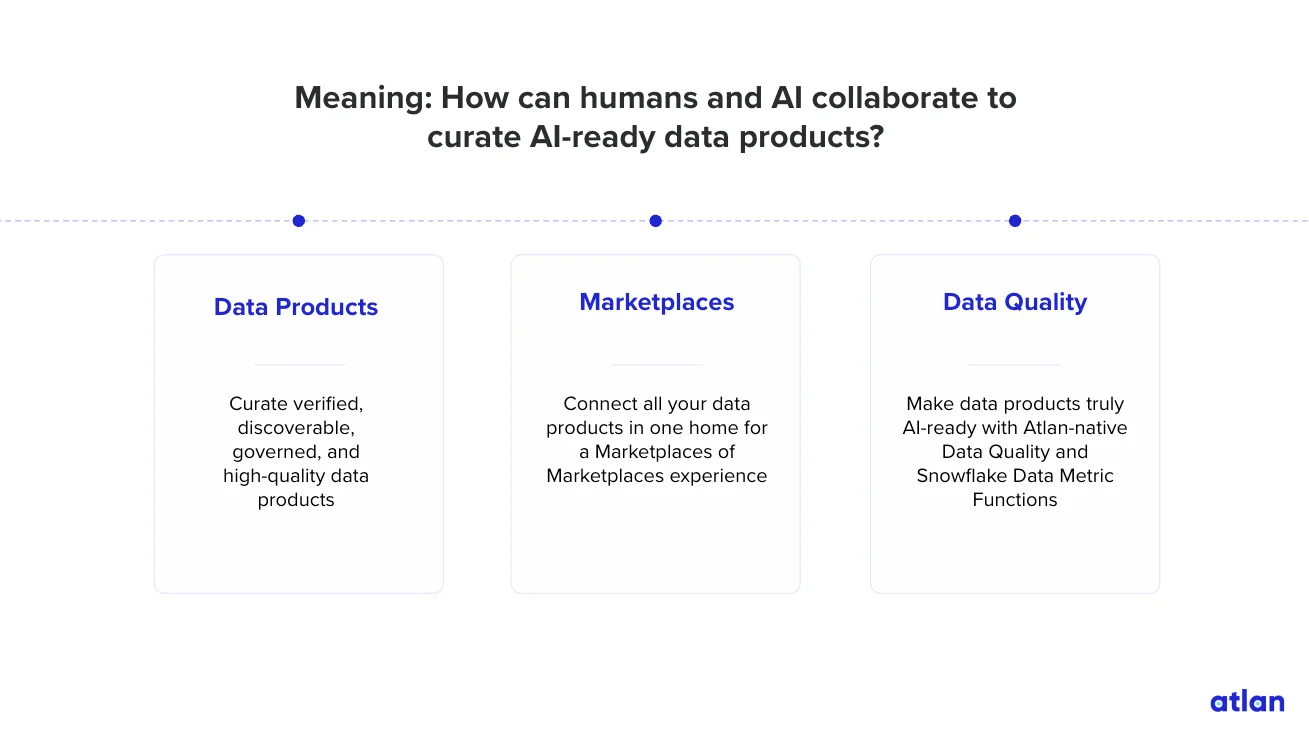
How can humans and AI collaborate to curate AI-ready data products? - Source: Atlan
“We actually are not trying to constrain people to only ask about things that are already in our semantic layer… we want the chatbot to trigger a workflow to define new terms through human review.” — Sharif Karmally
The result: a feedback loop between users and meaning, without hallucination.
Hurdle 3: Governance Can’t Be Bolted On
Permalink to “Hurdle 3: Governance Can’t Be Bolted On”In a pilot, governance is narrow. You scope data, access, and regulations tightly. But in production, AI runs across departments, geographies, and policies. Risks grow.
“Three people built three bots in two hours. We can’t stop them from building—but we can control what gets certified.” —VP, Fortune 500 Tech Company
“I’m okay with an HR chatbot using my payroll data. But I don’t want any other data and AI use cases in the company to touch payroll data. How can I be sure?” —CDAO, Public Software Company
What Atlan + Snowflake enable:
- Policy Center links models to training data, policies, and lineage
- Snowflake DMFs (Data Metric Functions) run scheduled checks (nulls, distincts, freshness)
- Atlan surfaces issues as quality signals in the UI
- Playbooks auto-trigger alerts and tickets in Slack, Jira, ServiceNow
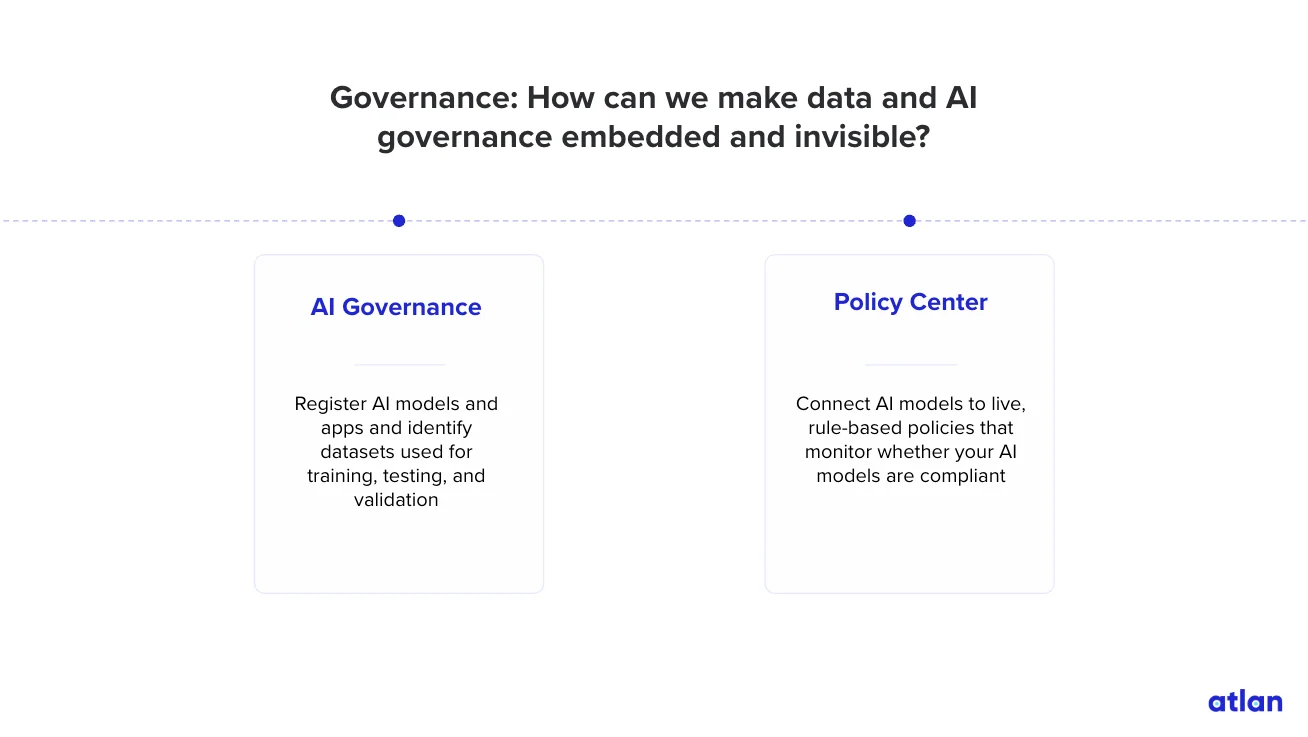
How can we make data and AI governance embedded and invisible? - Source: Atlan
“We’re not just surfacing broken pipelines or inaccurate models. We’re turning those failures into structured signals—ones that trigger trust workflows automatically.” —Gary Patterson, Director of Product, Atlan
The result: Governance becomes embedded and invisible.
The Metadata Framework: Unify, Collaborate, Activate
Permalink to “The Metadata Framework: Unify, Collaborate, Activate”To build AI you can trust, metadata must evolve from documentation to infrastructure.
1. Unify all context, semantics, and policies from systems like Snowflake, dbt, and ServiceNow.
2. Collaborate across personas—engineers, analysts, compliance, legal.
3. Activate that metadata in every interface where AI operates: copilots, dashboards, chatbots.
“If AI is electricity, metadata is the wiring.” —Gary Patterson, Director of Product, Atlan
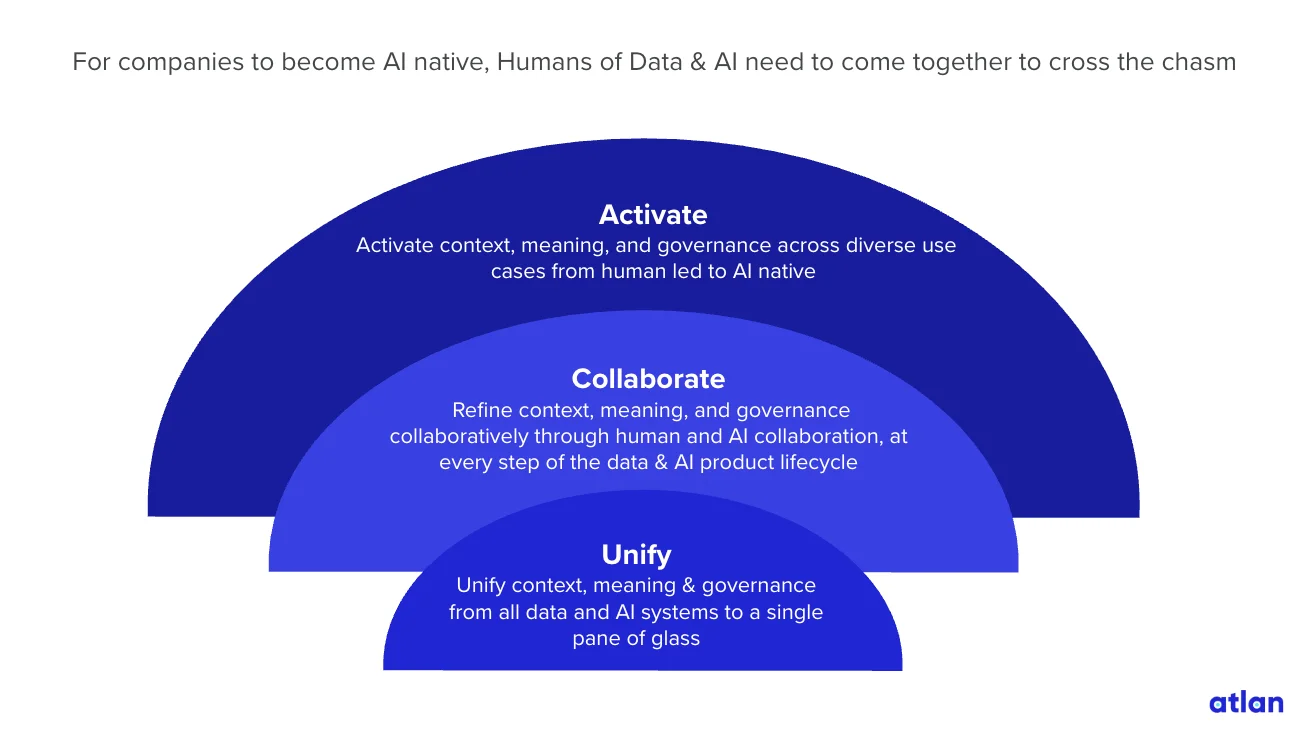
The Metadata Framework: Unify, Collaborate, Activate - Source: Atlan
Your Metadata Strategy Is Your AI Strategy
Permalink to “Your Metadata Strategy Is Your AI Strategy”You don’t need to slow down your roadmap. But you do need to ground it.
The best teams aren’t scaling AI by building more models. They’re doing it by treating metadata—lineage, contracts, policies—as infrastructure.
That’s what Atlan and Snowflake are building together: an operating layer of trust for the AI-native enterprise.
Want to See It Live?
Permalink to “Want to See It Live?”Join us at Snowflake Summit, Booth 1907 to explore the Metadata Lakehouse in action. Or request a personalized walkthrough to understand how trust, context, and governance scale inside your existing stack.
Share this article
Atlan is the next-generation platform for data and AI governance. It is a control plane that stitches together a business's disparate data infrastructure, cataloging and enriching data with business context and security.




















